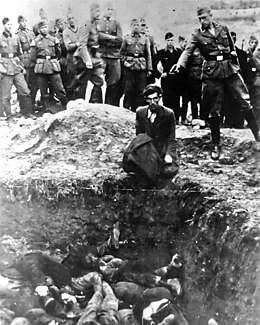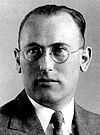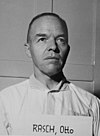
The Geheime Staatspolizei, abbreviated Gestapo, was the official secret police of Nazi Germany and in German-occupied Europe.

The Schutzstaffel was a major paramilitary organisation under Adolf Hitler and the Nazi Party in Nazi Germany, and later throughout German-occupied Europe during World War II.
Sicherheitsdienst, full title Sicherheitsdienst des Reichsführers-SS, or SD, was the intelligence agency of the SS and the Nazi Party in Nazi Germany. Established in 1931, the SD was the first Nazi intelligence organization and the Gestapo was considered its sister organization through the integration of SS members and operational procedures. The SD was administered as an independent SS office between 1933 and 1939. That year, the SD was transferred over to the Reich Security Main Office, as one of its seven departments. Its first director, Reinhard Heydrich, intended for the SD to bring every single individual within the Third Reich's reach under "continuous supervision".

Einsatzgruppen were Schutzstaffel (SS) paramilitary death squads of Nazi Germany that were responsible for mass murder, primarily by shooting, during World War II (1939–1945) in German-occupied Europe. The Einsatzgruppen had an integral role in the implementation of the so-called "Final Solution to the Jewish question" in territories conquered by Nazi Germany, and were involved in the murder of much of the intelligentsia and cultural elite of Poland, including members of the Catholic priesthood. Almost all of the people they murdered were civilians, beginning with the intelligentsia and swiftly progressing to Soviet political commissars, Jews, and Romani people, as well as actual or alleged partisans throughout Eastern Europe.

The Reich Security Main Office was an organization under Heinrich Himmler in his dual capacity as Chef der Deutschen Polizei and Reichsführer-SS, the head of the Nazi Party's Schutzstaffel (SS). The organization's stated duty was to fight all "enemies of the Reich" inside and outside the borders of Nazi Germany.
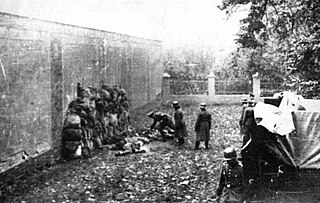
During World War II, the Nazi German Einsatzkommandos were a sub-group of the Einsatzgruppen – up to 3,000 men total – usually composed of 500–1,000 functionaries of the SS and Gestapo, whose mission was to exterminate Jews, Polish intellectuals, Romani, and communists in the captured territories often far behind the advancing German front. Einsatzkommandos, along with Sonderkommandos, were responsible for the systematic murder of Jews during the aftermath of Operation Barbarossa, the invasion of the Soviet Union. After the war, several commanders were tried in the Einsatzgruppen trial, convicted, and executed.
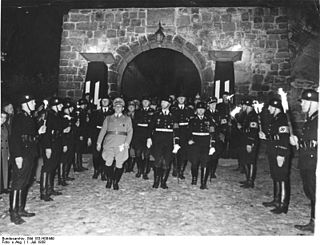
The Allgemeine SS was a major branch of the Schutzstaffel (SS) paramilitary forces of Nazi Germany; it was managed by the SS Main Office (SS-Hauptamt). The Allgemeine SS was officially established in the autumn of 1934 to distinguish its members from the SS-Verfügungstruppe, which later became the Waffen-SS, and the SS-Totenkopfverbände, which were in charge of the Nazi concentration camps and extermination camps. SS formations committed many war crimes against civilians and allied servicemen.
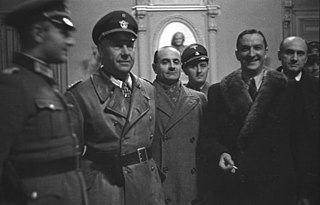
The Sicherheitspolizei, often abbreviated as SiPo, was a term used in Germany for security police. In the Nazi era, it referred to the state political and criminal investigation security agencies. It was made up by the combined forces of the Gestapo and the Kriminalpolizei between 1936 and 1939. As a formal agency, the SiPo was incorporated into the Reich Security Main Office (RSHA) in 1939, but the term continued to be used informally until the end of World War II in Europe.

Franz Walter Stahlecker was commander of the SS security forces (Sicherheitspolizei and the Sicherheitsdienst for the Reichskommissariat Ostland in 1941–42. Stahlecker commanded Einsatzgruppe A, the most murderous of the four Einsatzgruppen active in German-occupied Eastern Europe. He was fatally wounded in action by Soviet partisans and was replaced by Heinz Jost.
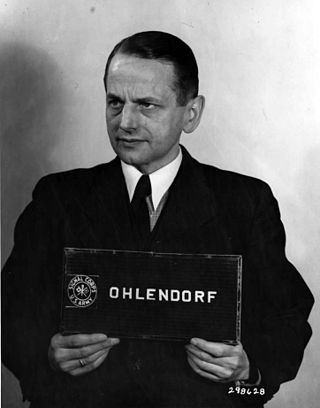
Otto Ohlendorf was a German SS functionary and Holocaust perpetrator during the Nazi era. An economist by education, he was head of the Sicherheitsdienst (SD) Inland, responsible for intelligence and security within Germany. In 1941, Ohlendorf was appointed the commander of Einsatzgruppe D, which perpetrated mass murder in Moldova, south Ukraine, the Crimea and, during 1942, the North Caucasus. He was tried at the Einsatzgruppen Trial, sentenced to death, and executed by hanging in 1951.

Emil Haussmann was a German SS functionary during the Nazi era. He was part of Einsatzkommando 12 of Einsatzgruppe D, which perpetrated the Holocaust in occupied Ukraine. Haussmann was charged with crimes against humanity in 1947 in the Einsatzgruppen Trial. Two days after his indictment, Haussmann committed suicide.
Units and commands of the Schutzstaffel were organizational titles used by the SS to describe the many groups, forces, and formations that existed within the SS from its inception in 1923 to the eventual fall of Nazi Germany in 1945.

Erich Ehrlinger was a member of the Nazi Party and SS. As commander of Special Detachment 1b, he was responsible for mass murder in the Baltic states and Belarus.
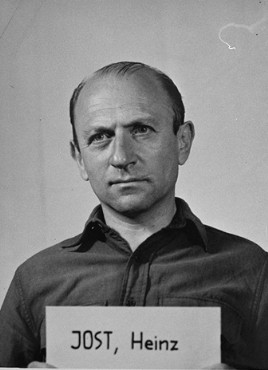
Heinz Jost was a German SS functionary during the Nazi era. He was involved in espionage matters as the Sicherheitsdienst or (SD) section chief of office VI of the Reich Security Main Office. Jost was responsible for genocide in eastern Europe as commander of Einsatzgruppe A from March–September 1942.
The Ninth Fort massacres of November 1941 were two separate mass shootings of 4,934 German Jews in the Ninth Fort near Kaunas, Lithuania. These were the first systematic mass killings of German Jews during the Holocaust. The question of where these killings fit into the development of the Final Solution is a matter of dispute among historians.

Karl Rudolf Werner Braune was a German SS functionary during the Nazi era and a Holocaust perpetrator. During the German invasion of the Soviet Union of 1941, Braune was the commander of Einsatzkommando 11b, part of Einsatzgruppe D. Braune organized and conducted mass murders of Jews in the Army Group South Rear Area, the Reichskommissariat Ukraine. For his role in these crimes, Braune was tried before an American military court in 1948 in the Einsatzgruppen trial. He was convicted, sentenced to death and executed in 1951.
Walther Karl Johannes Bierkamp, also sometimes spelled Walter Bierkamp was a German Nazi lawyer and SS-Brigadeführer. During the Second World War, he served as the commander of the Sicherheitspolizei or SiPo and Sicherheitsdienst or SD in occupied Belgium and Northern France and later in occupied Poland and in Baden & Württemberg. He also commanded Einsatzgruppe D, in the occupied Soviet Union. He was involved in Holocaust-related war crimes in Poland and the North Caucasus area. After the end of the war in Europe, he committed suicide.

Gustav Adolf Nosske was a German lawyer and SS-Obersturmbannführer. In 1941–42, he commanded Einsatzkommando 12 within Einsatzgruppe D, under the command of Otto Ohlendorf. Tried in the Einsatzgruppen Trial in 1948, Nosske was sentenced to life imprisonment. He was released early in December 1951.
Kriminalpolizei, often abbreviated as Kripo, is the German name for a criminal investigation department. This article deals with the agency during the Nazi era.
Günther Herrmann was a functionary in the SS of Nazi Germany during World War II and a convicted criminal. He commanded the Sonderkommando 4b and the Einsatzkommando 12 of the Einsatzgruppe C in the occupied Soviet Union and the Einsatzgruppe E in Croatia. In 1973, Herrmann was convicted for the murders committed in 1941–42 in the occupied Soviet Union and was sentenced to seven years in prison.
